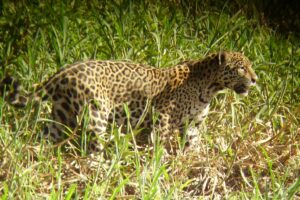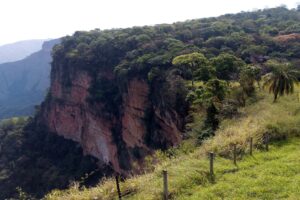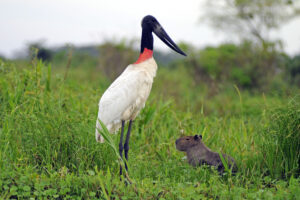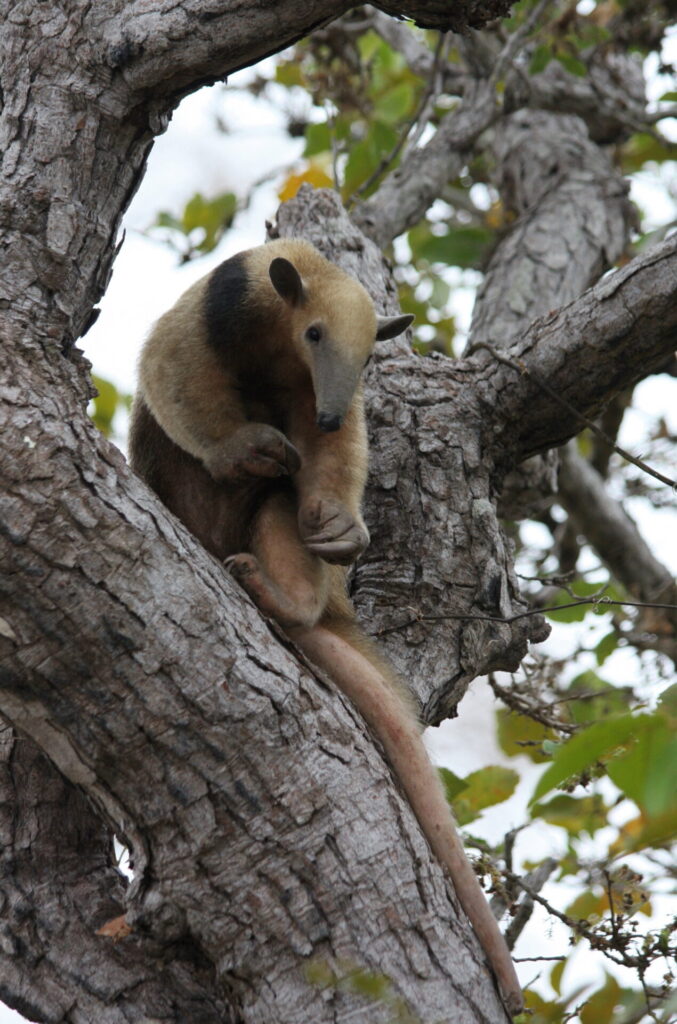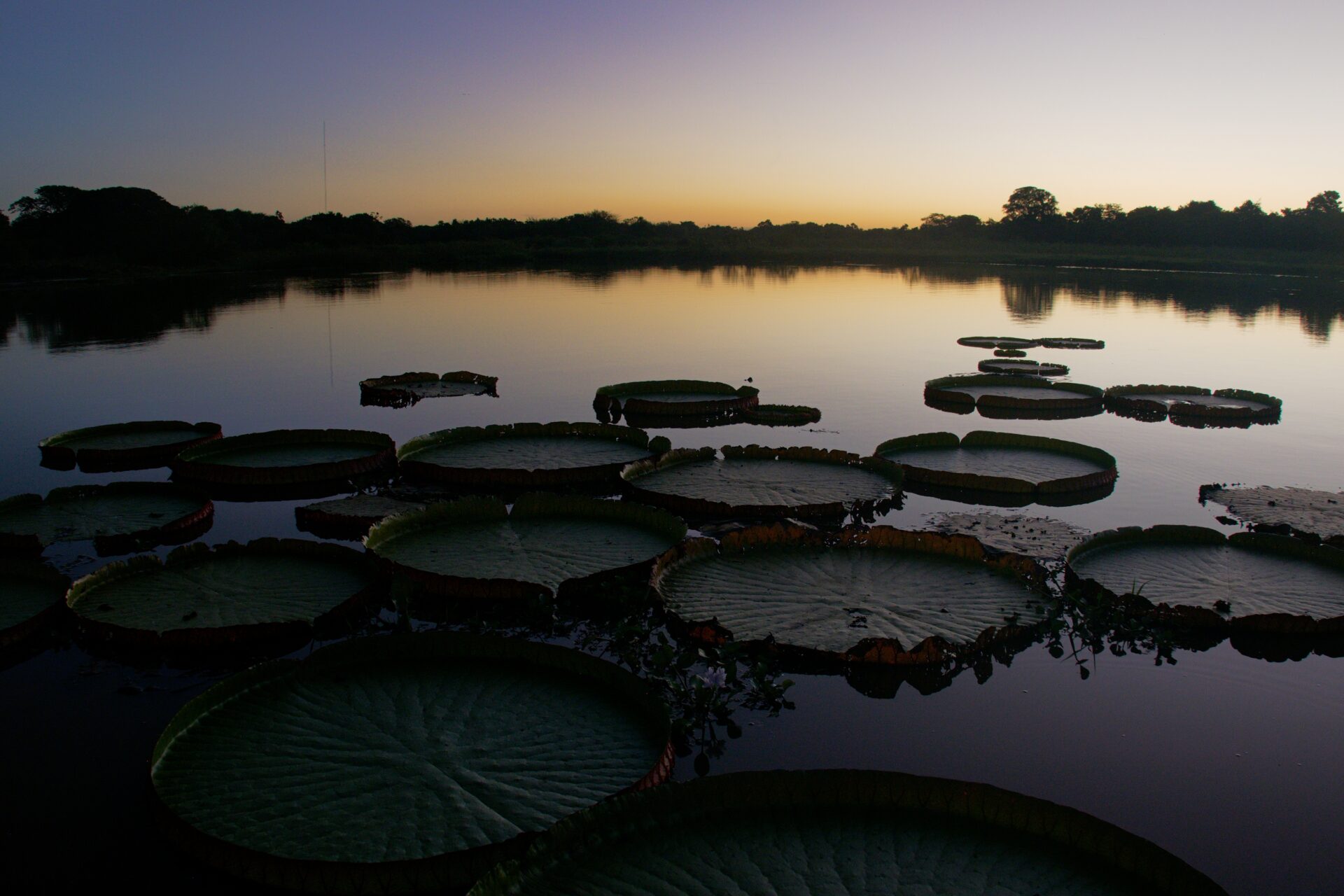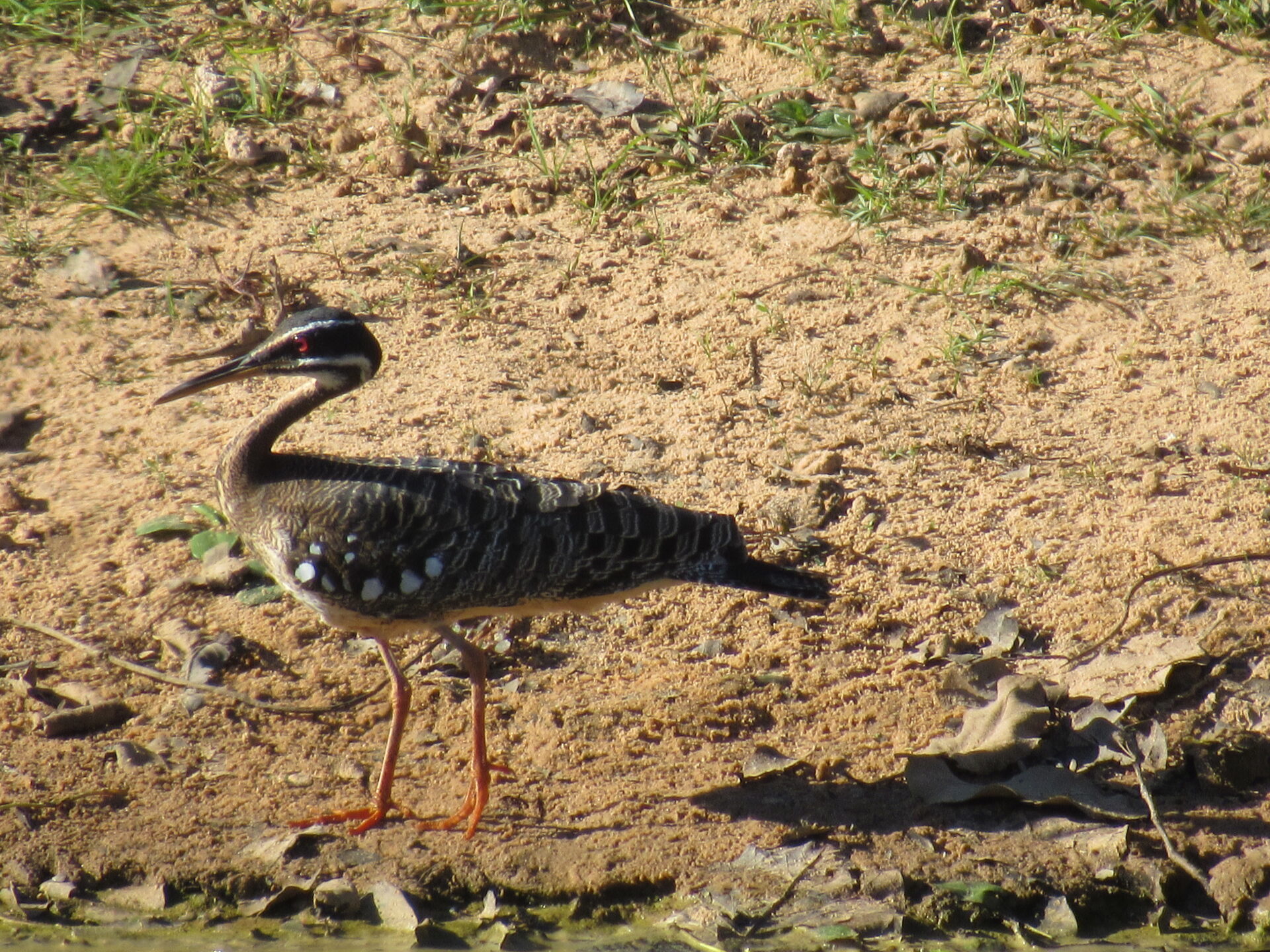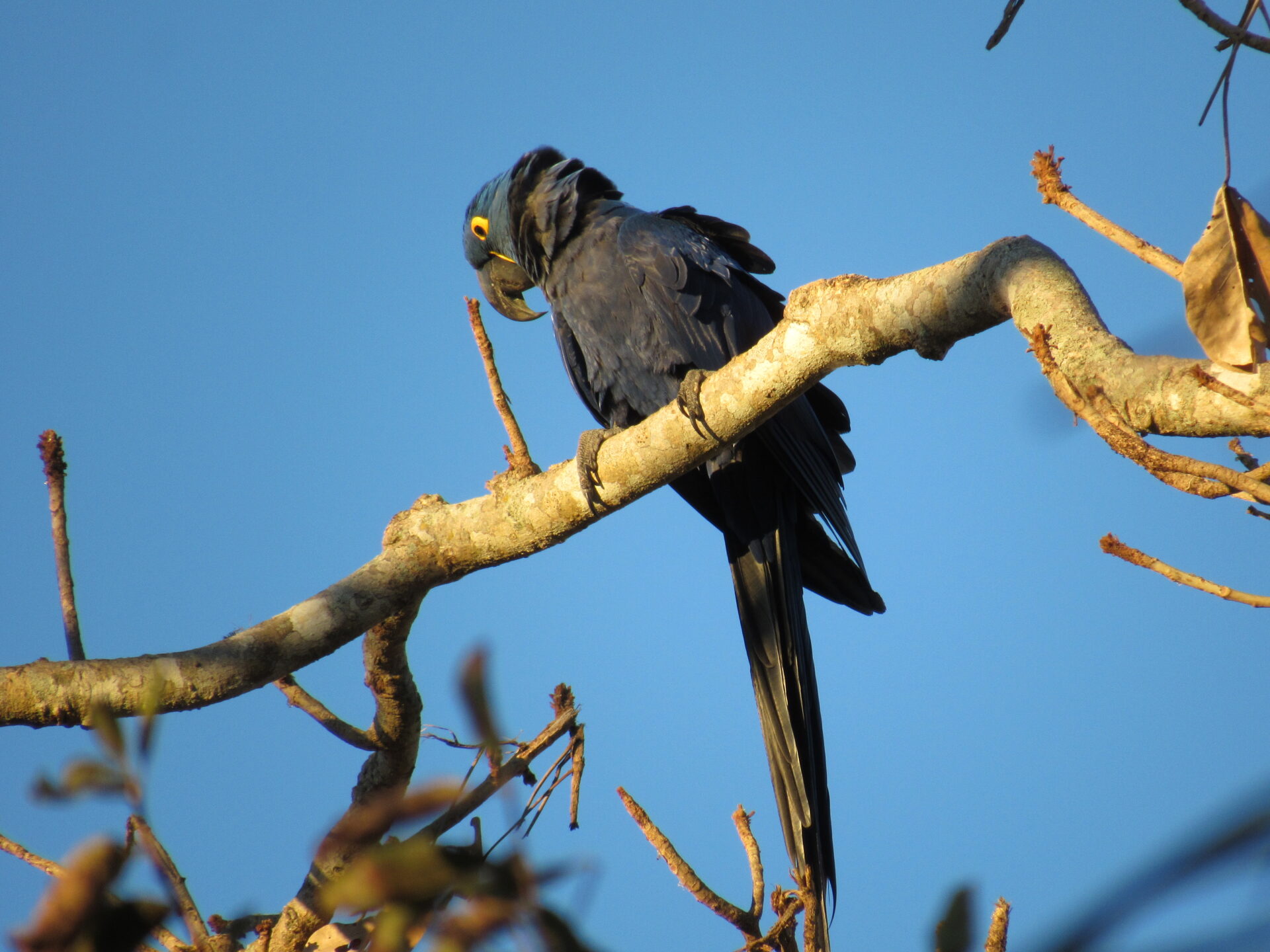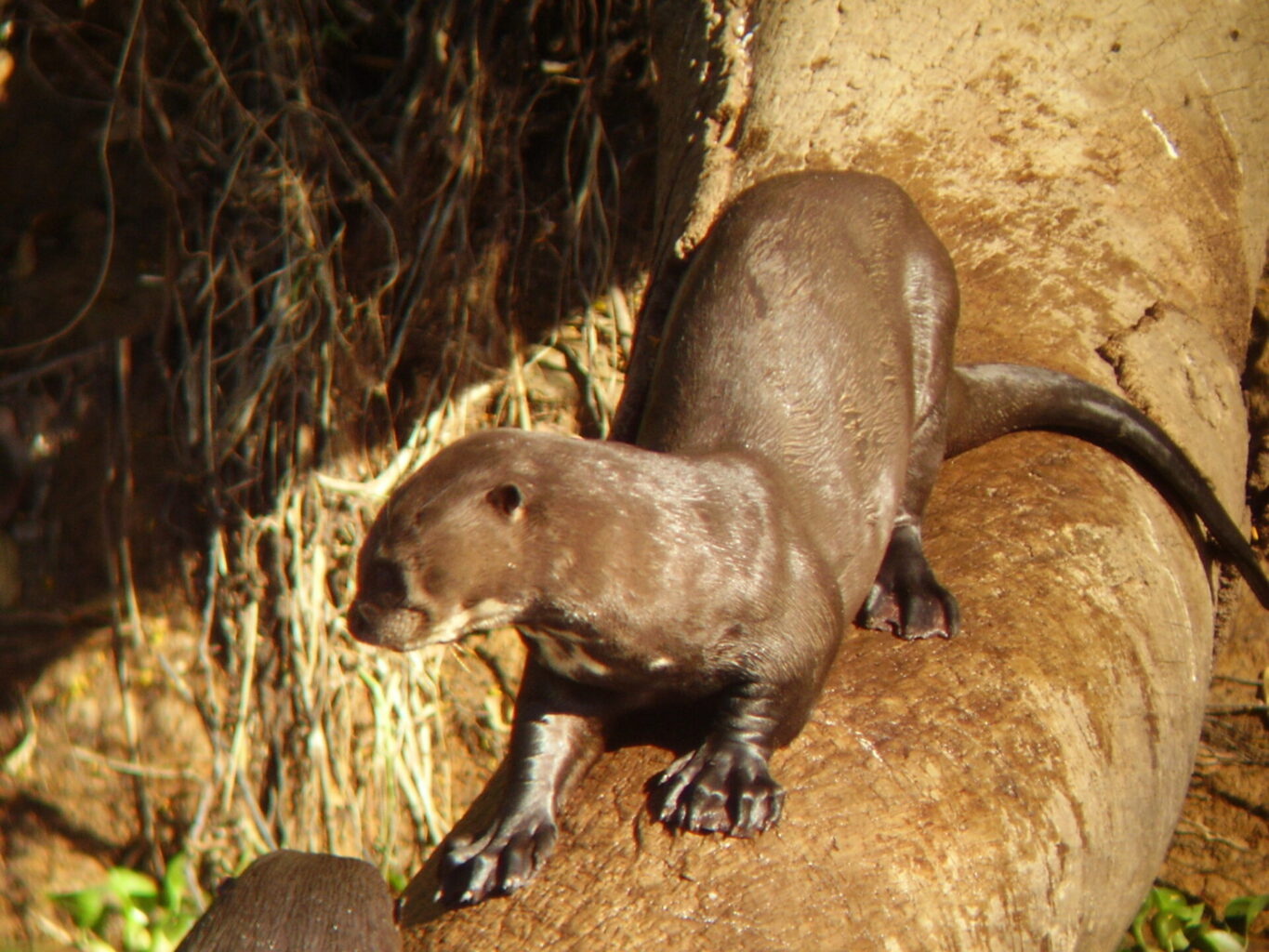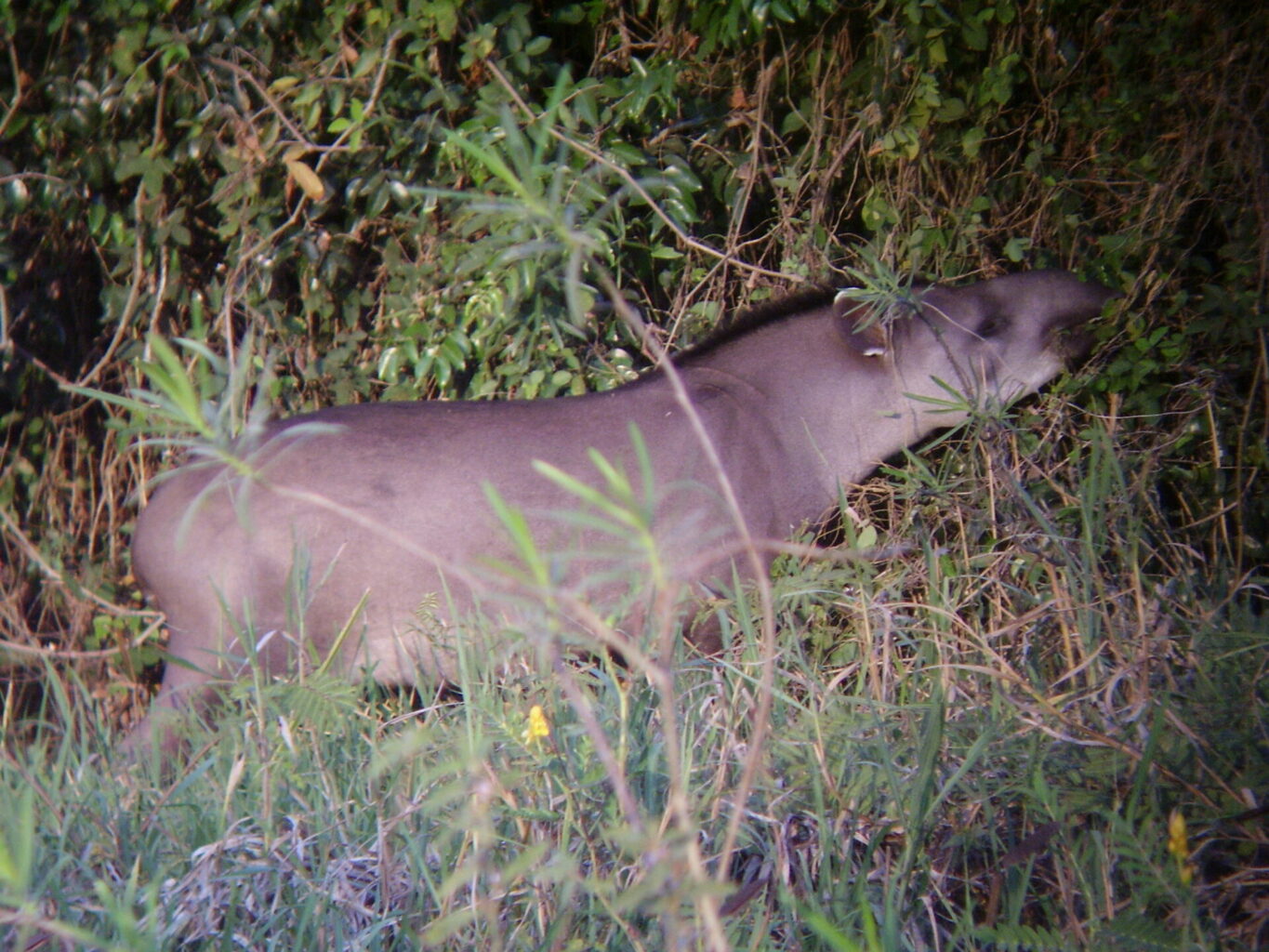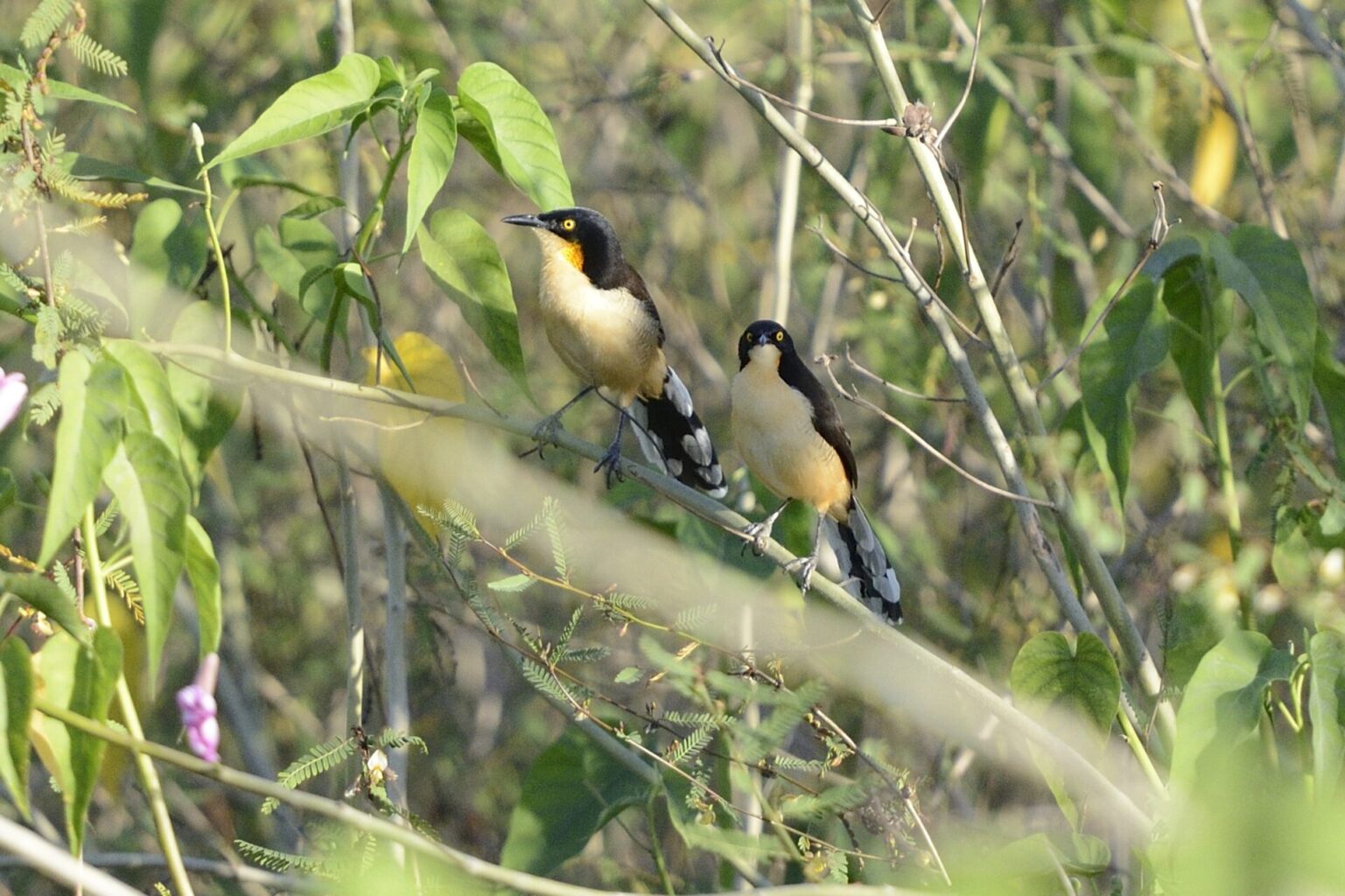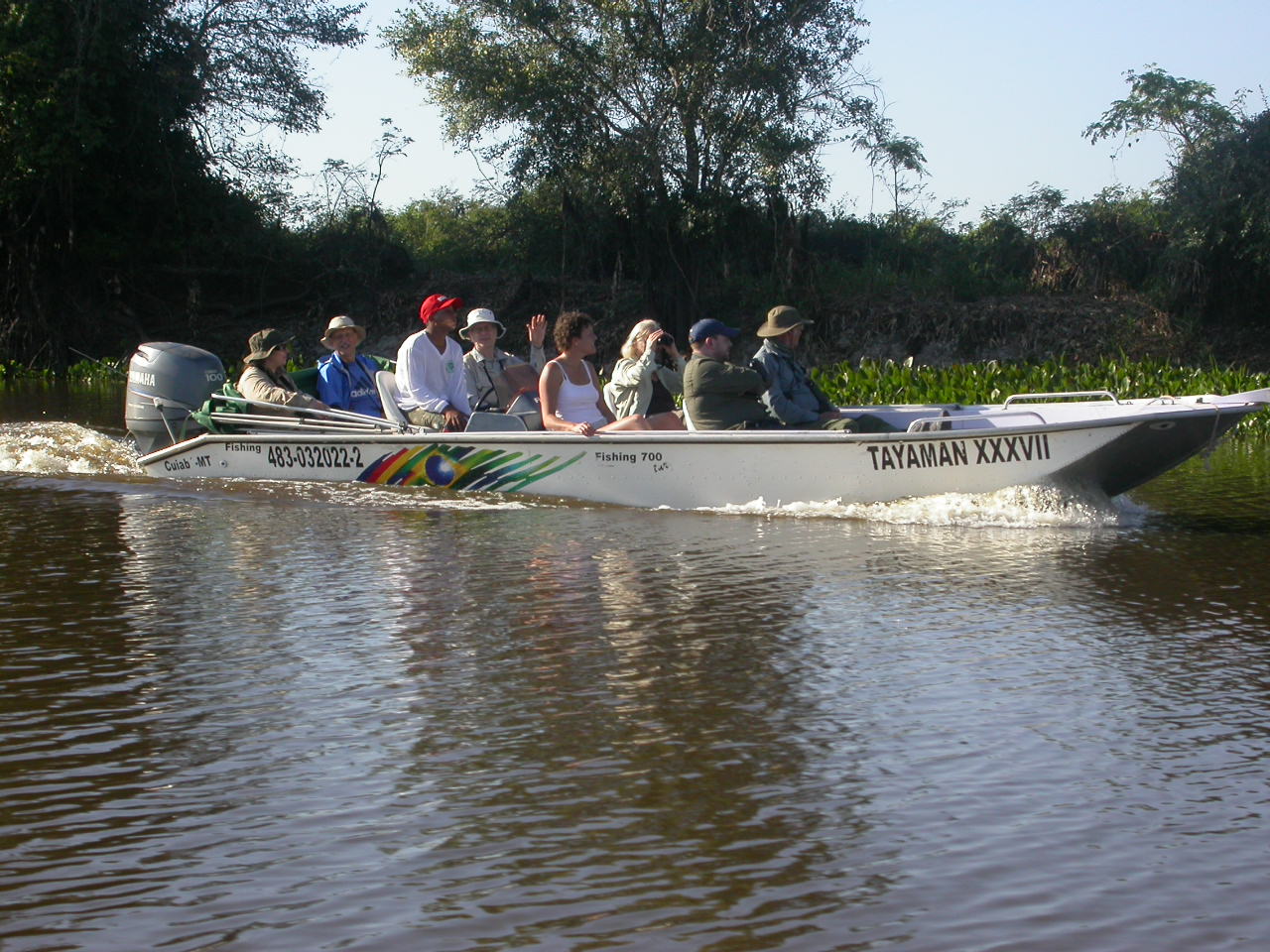The Pantanal & Atlantic Rainforest
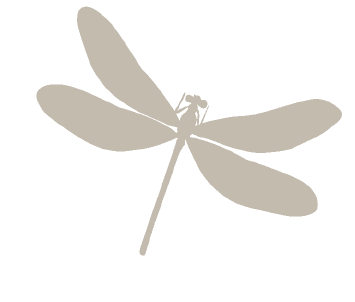
The Birds & Wildlife of Brazil
August 11 to 25, 2024
ONE SPACE REMAINING
$5,500 | ($500 deposit due upon registration)
Single Supplement: $570
12 participants max
T
he huge lowland plains of the Mato Grosso in Brazil, seasonally inundated during the rainy season, is known as the "Pantanal," meaning "Swampland." It is the shrinking of the wetlands during the dry season that creates the spectacular concentrations of wildlife for which the area has become world famous. The Pantanal is on three major migratory routes for birds, and as the water level retreats, considerable numbers of fish and amphibians become trapped in pools, providing a rich source of food.
In many respects this is perhaps the easiest place in South America to watch a wide variety of tropical wildlife, and our tour is timed to coincide with maximum birdlife, abundant flora, and the most tolerable weather conditions. In addition, the Pantanal is home to a number of charismatic mammals such as Giant River Otter, Anteaters, and Jaguar.
Just to the north of the Pantanal wetlands lies a completely different biome, the arid cerrado, where a quite different community of birds occur and where patches of gallery forest also provide a chance of species of a more Amazonian character. Flying into and out of Sao Paolo also gives us the opportunity to explore the Atlantic Rainforest near the coast. After a thorough exploration of the Pantanal and cerrado, we spend four days birding this rich environment, enjoying the contrast in both stunning scenery and birds.
Additional Information
(Click each tab to expand)
Flow of the Day: The itinerary is designed to maximize our experience with the great diversity of birdlife and ecosystems that Brazil offers. We won’t, however, be rushing from place to place to chase the largest species list possible. Our goal is to spend time appreciating the species we encounter at an enjoyable pace. Birding walks begin in the early morning, and we travel slowly to allow for the best bird and wildlife encounters.
Arriving early in Sao Paolo is encouraged! If you’d like some advice and where to go, talk to Chip about options.
Afternoon plans sometimes allow for some afternoon rest time at the lodges, though this is not always feasible when we are transferring between lodges and landscapes.
Climate: Temperatures are generally hot (or very hot) and sunny in the Pantanal by late morning, with temperatures in the daily range 75-95°F. Rain is possible at any time and may be prolonged on occasions. The weather at Chapada dos Guimaraes is more variable and typically a bit cooler, especially at either end of the day.
Clothing: Pack light field clothing of neutral colors. Bring several pairs of long pants and comfortable, light, airy shirts. Long-sleeved (relaxed fit) shirts are useful for protection from the sun, as is a light hat or cap. Good rain gear is essential, and a small umbrella is also recommended. Be sure to have a pair of comfortable walking shoes or hiking boots, plus a second pair of tennis shoes or sandals. A sweater or fleece is important. You may want more casual clothing for traveling or dinners. A small washcloth and handkerchiefs will be helpful.
Equipment: Bring a pair of binoculars, a field guide and a camera with extra batteries. The guides will have two spotting scopes. Pack sunglasses and sunscreen, a small flashlight or headlamp, a small alarm clock (a smartphone will work), insect repellent, a small daypack, and a small folding stool if you get tired standing for long periods observing birds and other wildlife. We will also supply a lengthier suggested packing list.
Health Considerations: Please consult your physician before the trip for any recommended immunizations. Mosquitoes can sometimes be a nuisance. We suggest a stick-type repellent for your face and hands, plus at least one pump-style container of repellent for your clothing. As for foods, safe bottled water is provided while on tours. All meals will be safe to eat, and your guides will alert you to any occasions when certain menu items should be avoided.
Participants should be able to hike on moderate terrain up to 3 miles per day, and be ready to expect conditions that may be hot, cold, dry, wet, or anything in-between.
Transportation: The land transportation is in a comfortable bus. Given the large distances we’ll be covering, there will also be three in-country flights.
Our NBNC guide is NBNC's Birding Ambassador and "emeritus" Executive Director Chip Darmstadt. Chip has guided NBNC excursions to Nicaragua, Costa Rica, Spain, Ecuador, Argentina, as well as stateside locations like Magee Marsh and Cape May for over 25 years.
North Branch Nature Center will be partnering with Clark Expediciones, based in Salta, Argentina. Founder Ricardo Clark has been a force behind conservation of the imperiled Yungas forests in the northern Andes. We will be joined by expert in-country bird guides, arranged by Clark Expediciones, throughout our entire adventure.
Accommodation in the Pantanal is in small comfortable hotels, which may lack the amenities of more luxurious establishments but compensate by being in ideal locations. Elsewhere we stay in tourist class hotels throughout. Accommodation is in twin-bedded rooms with private facilities but single rooms may be available on request.
The trip cost includes:
- Pre-departure orientation gathering (virtual)
- Expert NBNC guide
- In-country, English-speaking local bird guide
- All accommodations
- Entrance fees to parks and boat rides
- Comfortable, private transportation throughout the trip
- Airport transfers
- Bottled water, available at all times
- All meals during the trip starting and ending in Buenos Aires
The trip cost does not include:
- International airfare to and from Sao Paolo
- Transportation to/from airports in the US
- Three in-country flights (estimated to be $265, but subject to change once 2024 flight schedules are released).
- Cancellation (trip) insurance
- Alcoholic beverages, snacks and other incidentals
- Extra hotel services, such as laundry
- Guide gratuities
Ready to go to Argentina?
Email [email protected] to get signed up.
Payment Schedule
- A $500 deposit is required to reserve your space on the trip.
- 50% of the trip balance will be due 6 months before the departure date (February 11 2024).
- Single travelers must include the single supplement fee ($530) with this payment. Single rooms are limited on this itinerary, so please confirm with us that your request for a single room can be accommodated before sending payment.
- The remaining trip balance will be due 3 months before the departure date (May 11 2024).
All payments can be made via check to: North Branch Nature Center, 713 Elm Street, Montpelier, VT 05602
Cancellation Policies
We understand that incidents and emergencies arise that may force you to cancel your trip. However, NBNC invests considerable time and, in many cases, non-refundable payments to lodges and local contractors to secure our rooms and programming. NBNC aims to be as flexible as possible in our refund policy, but a full refund of your payments may not be possible after the dates indicated. All cancellations must be made via email to NBNC.
-
Cancellation more than 180 days before the trip: Full refund of all payments.
-
Cancellation 90-180 days before the trip: Refund of any payments minus the $500 deposit. If your space is filled by another traveler, we will also refund your deposit.
-
Cancellation 30-90 days before the trip: No refund guaranteed. If your space is filled by another traveler, we will provide a full refund minus the $500 deposit.
-
Cancellation less than 30 days before the trip: No refunds guaranteed.
Itinerary
(Click each tab to expand)
Today we depart on scheduled overnight flights from the United States to São Paulo. We will arrive in Brazil on the morning of August 12. Our trip leaders will recommend flight options several months before the journey begins. You are welcome and encouraged to arrive in São Paulo a day or two early, and our trip leaders can help you select arrangements.
Following an early morning arrival in Sao Paulo we board a domestic flight to Cuiaba, the capital of the Mato Grosso where we stay for one night. We should arrive at our hotel for lunch then in the afternoon will get an opportunity to stretch our legs and gain an introduction to Brazilian natural history in nearby surroundings. A population of the rare Pantanal Marmoset inhabit this area known as Varzea Grande and the birdlife is both colorful and plentiful with representatives from some of the Neotropical families such as macaws and tanagers, that we will be seeing throughout the tour.
We transfer by road to spend two nights at a private ranch near the Pixaim river which will be our base to explore the upper regions of the Pantanal floodlands.
Here we'll explore the 'Transpantaneira', an earth causeway that traverses 130 kilometers of wetlands and crosses 140 wooden bridges. This will be our main source of access to the marshes and regular stops at suitable vantage points. In the vicinity of Pixaim we will see considerable numbers of cormorants, herons, storks and ibises, all taking advantage of the rich pickings left by the retreating floods. One of the most striking of these birds is the huge Jabiru Stork, a scarce bird throughout most of its range but a familiar sight in the Pantanal.
The most visible mammal is the Capybara, the world's largest rodent, which occurs in large family groups browsing the vegetation under the watchful eyes of numerous Caimen. The rare Giant River Otter is another resident of the waterways and we will take a boat trip on the river to search for this species, an excursion that also offers a good chance of finding some of the more furtive wetland birds such as the enigmatic Sunbittern and Sungrebe. Other mammals live in the drier stretches of countryside where fortunate observers may occasionally see Lesser and even Giant Anteaters feeding on termites. Brown Brocket Deer and Marsh Deer both inhabit the Pantanal, and spotlighting along the Transpantaneira may yield sightings of Crab-eating Fox, Crab-eating Raccoons and several other creatures without crustacean prefixes!
Several species of small cats and the Brazilian Tapir inhabit the Pantanal, but as with Jaguars, good fortune is needed to observe one of these beautiful and secretive mammals.
Much of this northern section of the Pantanal is covered in scrubby woodland and open, dry areas with patches of gallery forest where birdlife ranges from Greater Rheas, Red-legged Seriemas and the very localized Long-tailed Ground-Dove in drier areas, to the similarly localized Chestnut-bellied Guan and Matto Grosso Antbird in damper, more heavily wooded contexts. We will spend our time here covering a broad cross-section of habitats to maximize our chances of seeing the greatest diversity.
Birds of prey are well represented throughout the Pantanal, with the ubiquitous Snail Kite and Black-collared Hawk being two of the most frequently seen raptors. We are likely to encounter them perching by open water on the lookout for snails and fish.
From Pixaim we will drive 90 kilometers to Porto Jofre at the end of the Transpantaneira for a three-night stay in a very nice lodge at the edge of the Rio Cuiaba. Travel is slow along this highway under the best of circumstances, which will give us the opportunity to look out for some uncommon roadside birds such as the beautiful Scarlet-headed Blackbird. As we get closer to Porto Jofre, open wetlands become more extensive and we will stop to admire the ranks of wetland birds such as Limpkins, Maguari Storks and many others.
One of the rarest residents of the Pantanal is the Hyacinth Macaw, the world's largest parrot. This magnificent bird is most often seen near Campo Jofre, and after settling in to our hotel we will take an evening stroll to a roosting area of this spectacular species. As dusk settles, huge Nacunda Nighthawks begin their evening activities.
As at Pixaim, we will spend our time at Porto Jofre covering a mixture of habitats, either on foot, or via short road journeys along the Transpantaneira.
We will also take a boat trip on the Rio Cuiaba where Black Skimmers roost on the sandbars in the company of numerous Large-billed and Yellow-billed Terns, Collared Plovers, and Pied Lapwings. A particular focus during this boat trip will be Jaguars, as this area has become one of the most reliable sites anywhere for this impressive cat, which has a tendency to lie out near the water's edge. Encounters with a Jaguar are a good possibility, but never guaranteed, even though the boatmen are primed with information on the most recent sightings.
We depart early today from Porto Jofre and retrace our steps back to Cuiaba and then beyond to our next destination of Chapada dos Guimaraes where we will be based for three nights at the edge of a huge escarpment overlooking Cuiaba and the plains to the south. Although primarily a traveling day we will pass along the full length of the Transpantaneira and stop when appropriate to stretch our legs or look at anything that catches the eye. We will arrive at the hotel in the evening and will no doubt be ready for dinner in their excellent restaurant.
Chapada Dos Guimaraes is on an ancient tectonic fault that is 500 million years old. When the Andes Cordilleras appeared on the west, the flat region of the Pantanal sank and the plateau (Chapada) rose. Then the water and wind erosion during millions of years carved natural sculptures, canyons and caves on buffy-cinnamon sandstone cliffs. Rivers and streams dig out their way creating huge waterfalls typical of Chapada´s scenery. From our hotel base we are well-placed to explore the nearby cerrado and forested areas. Although initially rather unassuming (being an arid habitat), cerrado contains a host of specialized bird species including Curl-crested Jay, White-rumped and White-banded Tanagers, Horned Sungem, Black-faced Saltator, White-eared Puffbird and others. Streams running from the high plateau are surrounded by gallery forest where numerous birds occur including various manakins, toucanets and woodpeckers.
Day 11 - We return from the Chapada to Cuiaba. There might be a necessary overnight in Cuiaba tonight, but ideally we will take an afternoon flight from Cuiaba to Curitiba. In this case, we arrive in Curitiba this same evening and drive the short distance of 40 km along paved road to the Mata Atlantica Park Hotel located on the slopes carpeted by Atlantic Rainforest at the border of Saint-Hilaire Lange National Park. We’ll have 3 full days in this spectacular setting.
In the early mornings we will take pre-breakfast birding walks of about one hour along the several trails around the hotel. One of them -the Onça Cachoeira- takes about one hour along the stream flowing down from the mountain and it offers excellent birding combined with inspiring landscapes. After breakfast we'll visit another trail in the Park known as "Salto do Tigre" for a walk in wet basal rainforest. Depending on weather, we might stay in the area until the afternoon, or we can return to the hotel for lunch and devote the afternoon for more birding in the surroundings. We'll also include night outing for Owls, Nightjars, Foxes and other nocturnal creatures.
On one of these mornings we will drive about one hour to another great place in Atlantic Forest: the forested coastal environment of Palmito National Park. Here we plan to walk the trails with a packed-lunch and return to our hotel in the afternoon.
On our final full day in this area, we head down the mountains to the coast at the delta of a large river surrounded by pristine Mata Atlantica forest. Here we will be in search of several specialties such as the endemic Red-tailed Parrot. We'll take a boat ride across the river to yet another section of forest where we will walk the trails with a packed-lunch. In the afternoon, we jump on another boat for an excursion along the mangroves to a couple of waterbird colonies including a Scarlet Ibis roost!
Today we'll return to São Paulo, perhaps after some morning birding if flight schedules allow. We will arrive directly at the São Paulo international airport in time to catch return flights to the United States.
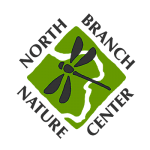
713 Elm Street
Montpelier, Vermont 05602
(802) 229-6206
Hours: Center Open Monday-Friday 9-4
Trails Open 24/7

